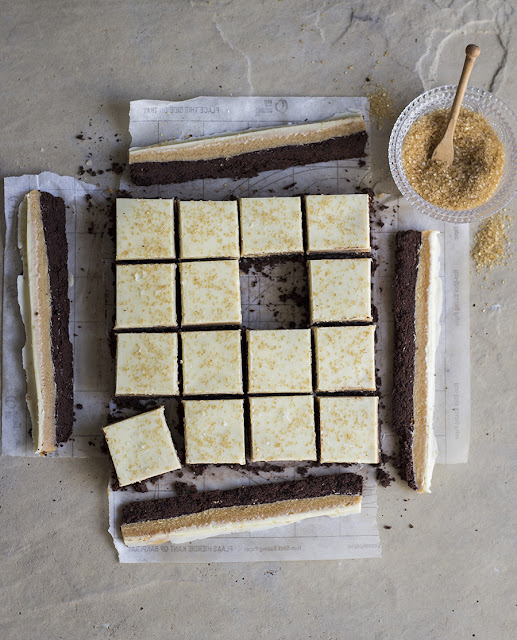Should I even bother typing an intro to this? I mean, with a title like that, I know you’re already thinking ‘Get in mah belleh!!!’ and working out how you can get to the shops and back in the quickest amount of time. I’m thinking it too. ‘Cos I know how flipping amazing these are!


For those of you still reading, let me break it down for you: cocoa shortbread, slapped with a thick layer of fudge, slathered with white chocolate and sprinkled with salt flakes. Jip, that’s fat on top of sugar, on top of butter (somewhere a dietician just quit her job cos she discovered what I do for a living… awkward!). BUT the key here is that it’s not just any sugar - it’s scrummalicious sugar (there are just too few food adjectives out there okay - inventing my own starting now).

I’ve used the crunchy caramelly Natura Demerara sugars for the job (Demerara sugars is crystallized from the first press of sugarcane juice). The Light Demerara is perfect for shortbread - the texture is fine (like wiggling your toes in beach sand!) so it dissolves while baking but still adds flavour. The Dark Demerara has gorgeous amber crystals (so pretty I used them as decoration on top of the white chocolate) which are perfect
for making a kick-ass caramel fudge. I’ve realised that sugar is so much more than
just adding sweetness and using proper unrefined sugar will add heaps of
flavour to your baking!

In my opinion, the best part, is the sexy off-cuts! I pretty much spent the entire morning munching on them while shooting - don’t think for a second they made it back into any sort of storage container (what is this ‘storage container’ you speak of? What is it used for?!).
Well, now my camera is covered in fudge… Wait, my camera is covered in fudge!
Now, go bake yourself happy while I contemplate whether licking my camera is socially acceptable…
P.S. This is what was left of the batch:
P.S. This is what was left of the batch:

Demerara Fudge Bars with White Chocolate and Sea salt
Makes 16-20
Shortbread base
150g cake flour
30g cocoa powder
130g butter, cut into blocks
Demerara Filling
130g milk powder (full-fat if possible)
150g Light Demerara Sugar
210g salted butter
160ml boiling water
Topping
200g white chocolate, melted
Sea salt flakes
Dark Demerara Sugar, for sprinkling
Grease and line a 20 x 20cm baking tray with baking paper.
Preheat the oven to 180 degrees celsius (160 if you’re using a fan-forced oven).
Combine the flour, cocoa, sugar and butter in a mixer fitted with a paddle attachment and mix until it forms a soft dough. Alternately, get your fingers dirty and rub all the ingredients together until well combined.
Press the dough into the prepared baking tin and prick the base with a fork.
Bake for 20 minutes or until golden. Allow to cool completely.
To make the Demerara fudge layer, place all the ingredients in a blender and blend for 1-2 minutes or until smooth and combined. Pour into a saucepan and stir continuously over a low heat until all the sugar has dissolved.
Bring to the boil and cook until the mixture turns golden brown and reaches soft ball stage (118C on a sugar thermometer). To test if it’s ready, drop a small amount into a small cup filled with tap water, it should form a soft, pliable ball. Remove from the heat and immediately pour over the shortbread. Allow to cool completely.
Spread the melted white chocolate over the top of the toffee then sprinkle with a little sea salt and the Demerara sugar. Allow to set then cut into bars using a hot knife.
Disclaimer: This post has been sponsored by Natura Sugars who produce a range of really special sugars that are unrefined and made according to traditional Mauritian sugar-making techniques. The sugars are non-GM, non-irradiated and unbleached with no preservatives, colourants or syrups added which basically means they are pure, natural and packed with flavour!





